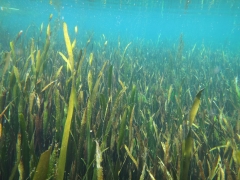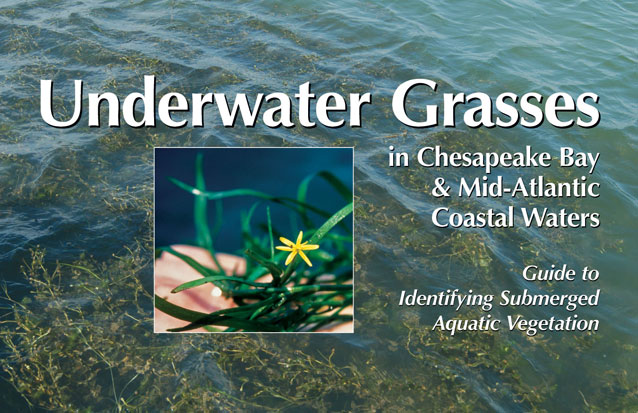Knauss legislative fellowships in Congress help build careers — and they're fun and educational. See our video and fact sheet for details.
Scavenging for Ancient DNA Samples
Dr. Grace Brush sat calmly at her desk as I scurried in a few minutes late, sweaty and hair damp from the warm rain falling outside. I had been feeling excited but jittery in anticipation of this first meeting with Grace, an eminent scholar of the Chesapeake Bay. In my discombobulated state I had become lost in the labyrinth of paths that wind their way through the Johns Hopkins University’s Homewood campus.
With a few short weeks of graduate school under my belt, my search for old samples of Vallisneria americana (a seagrass commonly known as wild celery) had barely begun. But why, you might be wondering, was I looking for little bits of old leaf tissue and seed? The four-word answer is, "to get ancient DNA!" A slightly longer answer is that I’m interested in studying the impact of human activities on the genetic diversity of V. americana in the Chesapeake Bay over time.
I plan to answer the following questions: How has the genetic diversity of this seagrass changed over time? Does the genetic diversity change in response to human activities such as farming or urbanization that alter the environment, or does it remain the same in the face of human impacts? Are these genetic responses the same or different in various parts of the Chesapeake Bay? And do genetic changes in wild celery improve its resilience to withstand environmental stresses? To study the genetic makeup of this plant over a span of many years I need old plant samples – centuries old – from which to extract DNA.
Studying the long-term resiliency of V. americana will help us to more accurately diagnose the Chesapeake Bay’s health problems. It is useful to study V. americana as opposed to some other aspects of the ecosystem because it is a bellwether species – one considered to be an early predictor of environmental damage and ecosystem change. Declines in V. americana often indicate trouble for the Chesapeake Bay.
I left Grace’s office feeling very pleased, with several boxes of vials in my arms. In the vials were the contents of soil cores she collected from the Chesapeake Bay in the 1970’s, in the Susquehanna Flats, Eastern Bay, and Furnace Bay, and these soil samples included V. americana seeds hundreds to thousands of years old, depending on their position in the core. Despite having found my first treasure trove, I was still short hundreds of samples. I’m studying V. americana genetics at the landscape scale, meaning that my study spans several areas in the upper Chesapeake Bay, and so I need many samples from each area of interest for the results to be meaningful.
.jpg) |
|
Page from George Harrison Shull's lab notebook, circa 1903. Credit: The National Herbarium. |
My next stop was the National Herbarium in Washington, D.C., part of the Smithsonian’s National Museum of Natural History. Museum Specialist Meghann Toner gave me a "behind-the-scenes" tour and helped me track down several 100-year-old leaf tissue samples from the Chesapeake Bay region. All were collected in the early 1900’s by naturalist-turned-geneticist George Harrison Shull, who would later become known for his work on corn genetics at Cold Spring Harbor Laboratory, in New York. After delving into digital archives of other herbaria (such as the Missouri Botanical Garden and the Harvard Herbarium) to look for more samples, I found that Shull is one of the only collectors who sought out V. americana specimens in my area of interest. I wondered if there might be a vault full of Shull samples from the upper Bay stored away in a lab somewhere, just like Grace’s old samples were. And so began my search for Shull’s proverbial treasure chest.
So far I haven’t found it. Although I’ve since tracked down a few more of his specimens from other herbaria, I have yet to uncover a large hoard of Shull specimens, and I am beginning to think that such a thing may not exist. His lab notebooks document only the handful of specimens I’ve located so far and as my advisor, Dr. Maile Neel, reminded me, many collectors take one or two samples of each plant species from a sampling area and then move on to repeat the process at a new site. This makes it unlikely that Shull took copious V. americana samples in any one area.
The best strategy for finding large collections seems to follow the mantra, "It’s not what you know. It’s who you know." I say this because most of my samples have come from personal connections. The second treasure chest came from Jeff Cornwell at the Horn Point Laboratory of the University of Maryland Center for Environmental Science. He was kind enough to share with me some collections made by the Maryland Department of Natural Resources in the 1950s and 1960s. Among the benthic materials in the vials he gave me are tiny pieces of dried V. americana leaf tissue that I will need to identify and remove from the mix.
I’m constantly on the lookout for more leads and am currently in the process of "cold-emailing" researchers who’ve worked in the region, such as those affiliated with the U.S. Geological Survey, to tease out more samples for my study. Maybe you can help me on my treasure hunt for more samples: please feel free to email me if you or a colleague might have old V. americana samples from the Chesapeake Bay! Thank you.
Photo, top left: Vallisneria americana, more commonly known as wild celery. Credit: Dr. Maile Neel.
See all posts to the Fellowship Experiences blog


